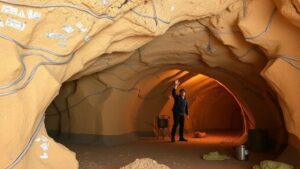Techniques for Finding Artifacts in Mudslide Areas With Layered Soil Sediments
Techniques for Finding Artifacts in Mudslide Areas With Layered Soil Sediments
The recovery of artifacts from mudslide areas presents unique challenges, particularly due to the complexity of layered soil sediments. These environments can give researchers valuable insights into historical events, prehistoric life, and cultural evolution. This article outlines the techniques utilized for successfully excavating and analyzing artifacts in such challenging conditions.
Understanding Mudslides and Their Effects on Soil Layers
A mudslide, or mudflow, is a rapid movement of water-saturated earth material down a slope. aftermath of a mudslide can create a stratified sediment layer that blankets existing archaeological deposits. Layers may vary in composition and age, often presenting a juxtaposition of artifacts from different periods.
For example, during the 2007 mudslide in La Conchita, California, researchers found vegetative debris mixed with cultural artifacts, demonstrating how natural disasters can disrupt historical contexts but also provide new opportunities for discovery.
Techniques for Artifact Recovery
There are several techniques and methodologies archaeologists employ to effectively locate and excavate artifacts in sediment-rich mudslide areas. Each technique is chosen based on the specific environmental conditions and research goals.
- Remote Sensing: Utilizing technologies such as ground-penetrating radar (GPR) and LiDAR (Light Detection and Ranging) allows for the identification of subsurface structures and stratigraphy without physical excavation. According to a study by C. O. Davis et al. (2019), GPR can provide high-resolution images of sediment layers, leading to the accurate positioning of potential artifact clusters.
- Layer Documentation: Documenting each soil layer meticulously during excavation is crucial. Soil texture, color, and composition are recorded to facilitate understanding of the depositional environment. For example, stratigraphic analysis performed during excavations in the 1937 landslide in Kilauea, Hawaii, showcased how variations in sediment layers reflect differing geological events and human activities over time.
- Systematic Excavation: Employing a grid system during excavation allows for methodical extraction and analysis. Each grid unit can be excavated in sections, preserving the integrity of the soil layers. It was through systematic excavation techniques that artifacts from the prehistoric period were recovered in the Pine Mountain mudslide, offering insights into early hunting practices.
- Floatation and Soil Sampling: Soil samples can be subjected to floatation techniques to recover small artifacts and ecofacts like seeds or charcoal. This is particularly useful in layers that have become compacted and difficult to excavate traditionally. Analysis of samples from the 2011 mudslide in Joplin, Missouri revealed numerous plant remains that provided dietary clues about the areas early inhabitants.
Challenges in Artifact Recovery
Working in mudslide areas poses substantial challenges including structural instability of sediment layers and the presence of contaminants. Also, the rapid flow of mud can cause loss of context, hindering accurate dating and interpretation of artifacts. Various strategies can mitigate these issues:
- Field Monitoring: Constant monitoring of weather and soil conditions can prevent further deposits from affecting excavation efforts. Regular assessments of slope stability may also help in designing safe excavation practices.
- Use of Protective Barriers: Erecting physical barriers can help contain excavated soil sections and prevent rain-runoff from mixing layers.
- Collaboration with Natural Hazard Experts: Engaging geologists and other specialists can provide insight into the behavior of the terrain and guide safe excavation practices.
Case Studies
Several archaeological investigations have successfully utilized the aforementioned techniques. The excavation following the 2008 mudslide at Glacier National Park revealed critical layers of sediment that contained artifacts and ecofacts dating back over 1,000 years. Utilizing GPR, researchers were able to pinpoint locations of interest and perform controlled excavations that yielded an abundance of historical data.
Another case study can be found in the excavation of the landslide deposits in the Teton Mountains, where multidisciplinary approaches–combining archeological fieldwork with sedimentology–resulted in the successful recovery of artifacts that informed new understandings of past human habitation patterns.
Conclusion and Actionable Takeaways
Finding and recovering artifacts in mudslide areas with layered soil sediments is a multifaceted challenge that requires a set of well-defined techniques and strategies. By leveraging modern technologies such as remote sensing and systematic excavation methods, researchers can unveil the past buried beneath the shifting earth.
For practitioners in the field, the following actionable takeaways can enhance archaeological efforts in mudslide areas:
- Incorporate remote sensing technologies at the initial assessment stages.
- Use systematic documentation of stratified layers during excavation.
- Establish collaborative networks with professionals across disciplines to address the complexities of excavation in unstable environments.
Ultimately, the rigorous application of these techniques not only increases the chances of discovering artifacts but also enriches the historical narratives that emerge from these fascinating geological landscapes.



